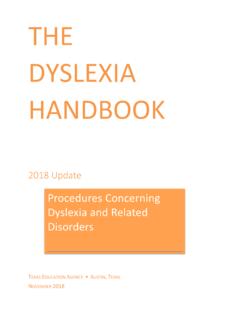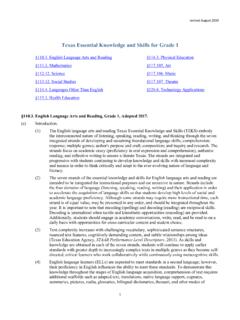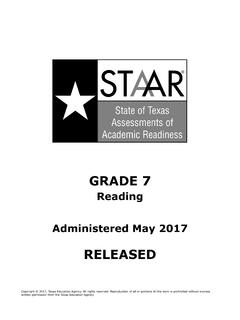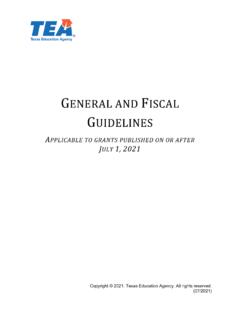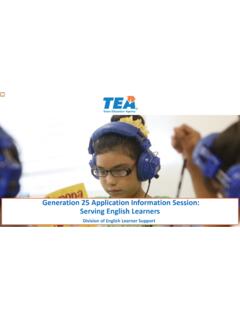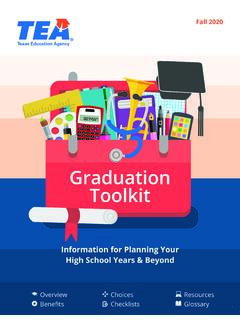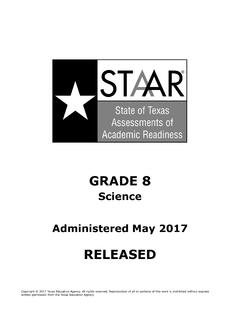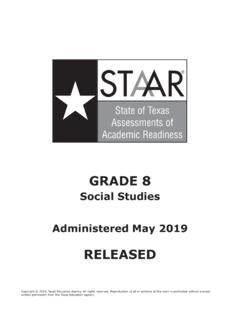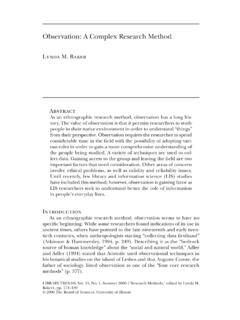Transcription of The Dyslexia Handbook Updates 2021 - Texas Education …
1 THE Dyslexia HANDBOOKP rocedures Concerning Dyslexia and Related Disorders2021 UpdateOctober 14, 2021 Dyslexia Handbook Brief History1987 First Handbook - Dyslexia and Related Disorders: An Overview of State and Federal Requirements1992 Dyslexia and Related Disorders: An Overview of State and Federal Requirements Revised1998 Dyslexia and Related Disorders Texas State Law, State Board of Education Rule and The Revised Procedures Concerning Dyslexia 2001 The Dyslexia Handbook : Procedures Concerning Dyslexia and Related Disorders2007 The Dyslexia Handbook : Revised 2007 Procedures Concerning Dyslexia and Related Disorders2010 The Dyslexia Handbook : Revised 2007, Updated 2010 Procedures Concerning Dyslexia and Related Disorders2014 The Dyslexia Handbook Revised 2014 Procedures Concerning Dyslexia and Related Disorders 2018 The Dyslexia Handbook Procedures Concerning Dyslexia and Related Disorders Update 20182021 The Dyslexia Handbook Procedures Concerning Dyslexia and Related Disorders Update 2021 Dyslexia Handbook Chapters Definitions and CharacteristicsScreeningProcedures for Evaluation and Identification of Students with DyslexiaCritical Evidence-Based Components of Dyslexia Instruction DysgraphiaIIIIIIIVVC hapter 1: Definitions and CharacteristicsEvidence-Based Core Reading Instruction (Tier 1) House Bill 3, passed by the 86thLegislature, requires each school district and open enrollment charter school to provide for the use of a phonics curriculum that uses systematic direct instruction in kindergarten through third grade to ensure all students obtain necessary early literacy skills.
2 District and charter schools must ensure that all kindergarten, first, second, and third grade teachers attend a teacher literacy achievement academy to increase teacher knowledge and implementation of the science of teaching reading. Additionally, districts and charter schools must certify to the agency that they prioritize placement of highly effective teachers in kindergarten through second grade and have integrated reading instruments used to diagnose reading development and comprehension to support each student in prekindergarten through third grade. This Handbook assumes that all students have received strong systematic reading instruction in tier 1. This Handbook assumes that all students have received strong systematic reading instruction in tier 2:ScreeningFederal Requirements Child Find In addition to state and local requirements to screen and identify students who may be at risk for Dyslexia ,there are also overarching federal laws and regulations to identify students with disabilities, commonly referred to as Child Find.
3 Child Find is a provision in the Individuals with Disabilities Education Act (IDEA), afederal law that requires the state to have policies and procedures in place to ensure that every student in thestate who needs special Education and related services is located, identified, and evaluated. The purpose of theIDEAis toensurethat studentswithdisabilitiesareoffereda freeandappropriate publiceducation( 1400(d); 34 ). Because a student suspected of having Dyslexia may be a student with a disabilityunder the IDEA, the Child Find mandate includes these students. Therefore, when referring and evaluatingstudents suspected of having Dyslexia , LEAs must follow procedures for conducting a full individual and initialevaluation (FIIE) under the IDEA. Because a student suspected of having Dyslexia may be a student with a disabilityunder the IDEA, the Child Find mandate includes these : State Requirements Texas Education Code (TEC) requires that all kindergarten and first-grade students be screened for Dyslexia and related disorders.
4 TEC requires administration of a reading instrument to diagnose student reading development and comprehension to all kindergarten, first, and second grade students. The current list of free, approved reading instruments for includes the required elements of a Dyslexia screener ( ). Districts and charter schools may use an instrument from the approved list to satisfy both requirements should they choose to do so. Screener Criteria Figure Criteria for English and Spanish Screening Instruments KindergartenFirst GradeLetter Sound Knowledge or Letter Naming FluencyWord Reading Accuracy or FluencyPhonological AwarenessPhonological AwarenessInterpretation of Data It is important to remember that atany point in the data review process a referral for a FIIE under the IDEAmay be initiated. Parents also have the right to request a FIIE at any time. Regardless of the process in place forscreening and data review, whenever accumulated data indicate that a student continues to struggle withone or more of the components of reading, despite the provision of adequate instruction and intervention,the student must be referred for a full individual and initial evaluation under the IDEA.
5 Figure Universal Screening and Data Review for Reading Universal Screening and Data Review for Reading Risk 12In kindergarten and first grade, universal screening for reading and Dyslexia is administered as required by TEC and (a) Kindergarten students must be administered a reading instrument at the beginning of the year (BOY), and may be administered a reading instrument at middle of year (MOY), and end of year(EOY) Kindergarten students must be screened for Dyslexia at the end of the schooly e a r. First grade students must be administered a reading instrument at BOY and may be administered a reading instrument at MOY, andEOY First grade students must be screened for Dyslexia not later than the screener show the student MAY be at risk for reading difficulties? NoYe sNext SlideFigure Universal Screening and Data Review for Reading Risk13 Does the screener show the student MAY be at risk for reading difficulties? Continue grade level, evidence-based core reading instruction.
6 (Tier 1)Collect and review quantitative and qualitative data on the student (See Figures and the analysis show that the student exhibits characteristics of Dyslexia or other specific learning disabilities?Ye sNoEndsNoYe sNext SlideFigure Universal Screening and Data Review for Reading Risk14 Seek parental consent for a Full Individual Initial Evaluation (FIIE) and, if the school receives consent, conduct the FIIE within 45 school days, while continuing to provide grade level, evidence-based core reading instruction (Tier 1) and providing appropriate tiered interventions. The ARD committee (including the parent) meets to review the results of the grade level, evidence-based core reading instruction (Tier 1) and provide any other appropriate tiered interventions. See Figure sNoDoes the analysis show that the student exhibits characteristics of Dyslexia or other specific learning disabilities?Chapter 3:Procedures for Evaluation and Identification of Students with DyslexiaChapter 3: Single Pathway for Dyslexia and Related Disorders IdentificationThe 2018 Dyslexia Handbook outlined two pathways for the identification of children suspected of having Dyslexia : Section 504 Dyslexia evaluation or an IDEA 2021 Dyslexia Handbook streamlines the process and clarifies that anytime the LEA suspects that the student has Dyslexia or a related disorder,and needs services, the LEA must seek parental consent for a Full Individual Initial Evaluation (FIIE) under the Pathway to the Identification and Provision of Instruction to Students with Dyslexia17 Figure Pathway to the Identification and Provision of Instruction to Students with Dyslexia18 Continue grade level, evidence-based core reading instruction.)
7 (Tier 1)B. Collect and review quantitative and qualitative dataDoes the analysis show that the student exhibits characteristics of Dyslexia or other specific learning disabilities?NoYESA. Universal screening for kindergarten and first grade students Does the screener show the student is at risk for reading difficulties? In all grades, is the student suspected of having Dyslexia or any other specific learning disability?NoYe sNext SlideEndsFigure Pathway to the Identification and Provision of Instruction to Students with Dyslexia19 Continue grade level, evidence-based core reading instruction (Tier 1) and provide any other appropriate tiered interventions. C. Seek parental consent and conduct Full Individual and Initial Evaluation (FIIE).Does the parent give consent for an FIIE?NoYe sB. Collect and review quantitative and qualitative dataDoes the analysis show that the student exhibits characteristics of Dyslexia or other specific learning disabilities?NoYe sNext SlideEndsSlide added to handout to ensure information in the webinar voice over is easily found in the handout.
8 If following along with the webinar, this slide will not appear. Implementation GuidanceNote:It is critical that parents and guardians are informed of the procedural protections and rights afforded to them and their child under the Seek parental consent and conduct Full Individual and Initial Evaluation (FIIE).Does the parent give consent for an FIIE?Key Takeaway:When an LEA seeks parental consent: Ensure consent is informed Include proper prior written notice Provide the notice of procedural safeguardsFigure Pathway to the Identification and Provision of Instruction to Students with Dyslexia21D. Seek parental consent for a Section 504 evaluation. Does the parent give consent for Section 504 evaluation?E. Conduct FIIEDoes the student have an IDEA eligible condition such as Dyslexia or a related disorder?C. Seek parental consent and conduct Full and Individual Initial Evaluation (FIIE).Does the parent give consent for an FIIE?NoYe sNext SlideNoYe sYe sSlide added to handout to ensure information in the webinar voice over is easily found in the handout.
9 If following along with the webinar, this slide will not appear. Implementation GuidanceNote: Schools should work to explain to parents that consenting to an evaluation under IDEA is notthe same as consenting to special Education services. Explain that special Education services can never be provided without their consent, even if they consent to conducting the FIIE. Make sure parents and guardiansunderstand that after the FIIEis complete they will be part of the team that makes the determination about eligibility and services. Help parents and guardians understand that the FIIE is an opportunity to gather all the information and data about their child so that they can participate with the rest of the ARD committee in making informed the parent give consent for an FIIE?Schools may not in any way persuade or encourage parents and guardians to refuse giving consent to conduct an evaluation under may be identified through Section 504 in situations where parents or guardians refuse consent to an evaluation under IDEA (Box D on flowchart) No Figure Pathway to the Identification and Provision of Instruction to Students with Dyslexia23D.
10 Seek parental consent for a Section 504 evaluation. Does the parent give consent for Section 504 evaluation?E. Conduct FIIEDoes the student have an IDEA eligible condition such as Dyslexia or a related disorder?F. Conduct an evaluation under Section 504. Does the student s Dyslexia or related disorder substantially limit one or more of life s major activities such as learning, reading, writing, or spelling?G. The ARD committee determines if a need for special Education services exists. Does the student require special Education because of the identified IDEA eligible condition? Continue grade level, evidence-based core reading instruction (Tier 1) and provide any other appropriate tiered interventions. NoYe sYe sNoYe sNext SlideEndsNoYe sNext SlideFigure Pathway to the Identification and Provision of Instruction to Students with DyslexiaIf, through the evaluation process, it is established that the student has the condition of Dyslexia , asdescribed in Chapter 1, then the student meets the first prong of eligibility under the IDEA (identification ofcondition).
